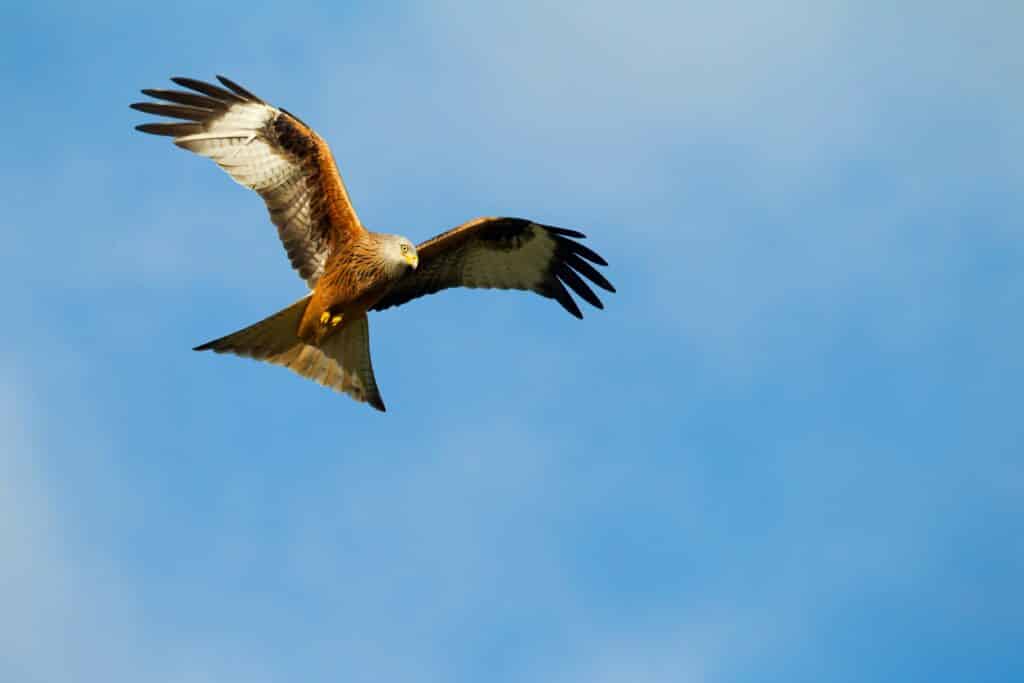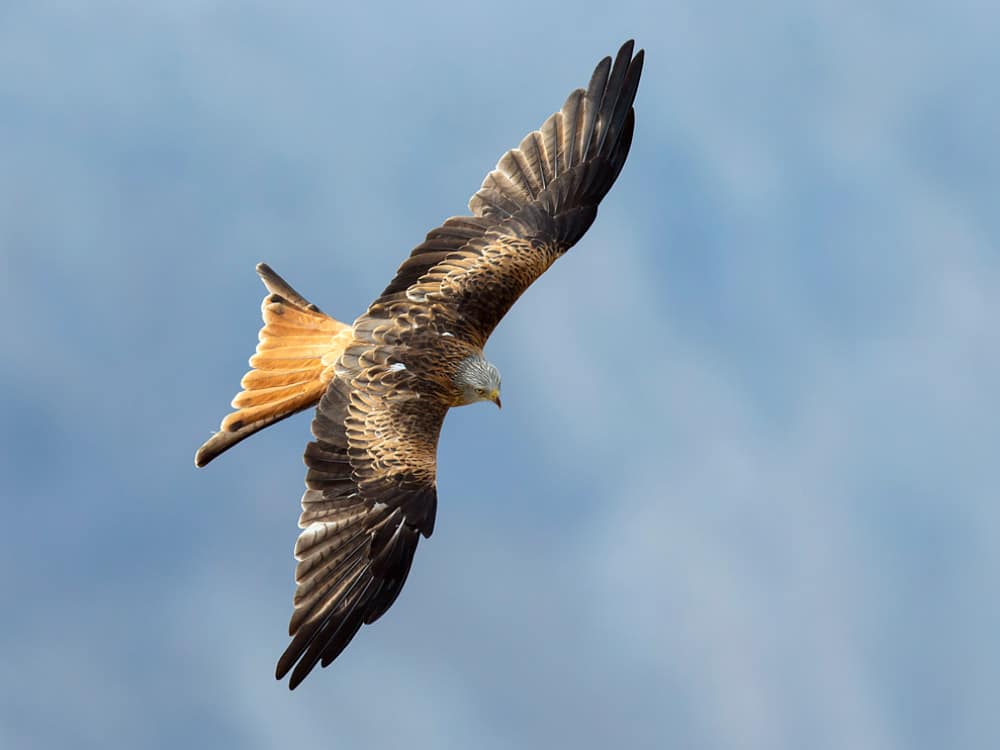Welcome to an enriching journey through the enchanting world of the Red Kite. Recognised by its scientific name, Milvus milvus, this bird of prey is a sight to behold, particularly when it takes to the skies over its favourite hunting grounds in the UK. Distinguished by their graceful flight patterns and stunning appearance, these raptors have become a source of fascination for bird enthusiasts and casual observers alike.
The Fascinating Physical Traits of Red Kites
The Intricate Aesthetics
Red Kites carry a distinctive charm owing to their reddish-brown bodies and starkly contrasting black wingtips. Their deeply forked tails, a signature feature, add to their overall aesthetic appeal. The combination of these features creates a mesmerising visual spectacle in the sky, setting them apart from other birds of prey.
Notable Body Size and Weight
The Red Kite, as a medium-sized bird of prey, strikes a delicate balance between size and weight. An adult kite typically weighs between 800 grams and 1.2 kilograms. While this body size may seem fairly standard for birds of their kind, their length, which ranges from 60 to 70 centimetres, imparts a uniquely imposing visual element.
Impressive Wings and the Flight Patterns
The real magic unfolds when a Red Kite spreads its wings. With a wingspan extending up to two meters and a relatively light body, these birds are capable of creating a captivating ballet of movement in the sky. Their unrivalled flight patterns, marked by effortless soaring and gliding, are a true testament to their aerial agility.

Understanding the Habitat and Distribution of Red Kites
Geographical Spread
Red Kites are predominantly found in Western Europe, most notably in England, Wales and parts of Northern Ireland. However, their adaptive nature allows them to inhabit regions in Northern Africa and parts of Asia as well, contributing to a broad geographical distribution.
Preferred Habitats
Red Kites are fond of open spaces. This preference leads them to inhabit areas such as grasslands, farmlands, nature reserves, and the fringes of forests and wetlands. These environments provide a clear vantage point for hunting and a wide variety of food sources to sustain their varied diet.
How Red Kites Adapt to Their Habitats
Adaptability is key to the survival of Red Kites in these varied habitats. Their sharp eyesight, nimble flight, and opportunistic feeding habits make them well-suited to the demands of these open spaces. It is in these environments that they hunt, breed, and play a crucial role in the ecosystem.
Social Behavior and Lifespan Of Red Kites
The Sociable Nature
Red Kites are communal birds. During the breeding season, they form groups and exhibit coordinated behaviour, often seen in the collective care and protection of their young. A group of feeding kites presents a spectacle of dramatic swoops and agile aerobatics, showcasing their social cohesion and aerial prowess.
Lifespan and its Implications on Population
After surviving the initial vulnerable year, Red Kites can live up to an impressive 25 years in the wild. This relatively long lifespan allows them ample time to establish breeding territories and contribute significantly to the growth of the kite population.
Their Daily Life
Red Kites are diurnal birds, meaning they are active during the day. Their mornings are typically reserved for hunting, while the afternoons are spent soaring high on thermal currents, scouting for an easy meal or resting in their nests.

The Diverse Diet of Red Kites and Its Role in Ecosystem
Feeding Habits
Red Kites are not picky eaters. Their diet includes a variety of items, ranging from small mammals, birds, carrion, and even waste. Interestingly, their consumption of waste helps keep the environment clean, particularly in urban areas where they have become a common sight.
Hunting Techniques
When hunting, Red Kites use their keen eyesight and aerial agility to their advantage. They hover high above the ground, scanning the area for potential meals. Once a target is identified, they swoop down swiftly and snatch their prey in a quick, precise strike.
Importance of Scavenging for Survival
Scavenging is an essential aspect of the Red Kite’s survival strategy. They feed on dead animals, playing a crucial role in cleaning up the environment and reducing the spread of diseases. This behaviour is particularly beneficial during the harsh winter months when live prey may be scarce.
Reproduction and Life Cycle of Red Kites
Courtship and Mating Rituals
The breeding season of Red Kites, which begins in spring, is characterised by an elaborate display of aerial acrobatics. The male and female engage in high-flying displays, mid-air food exchanges, and loop-the-loop flights. These rituals not only strengthen the bond between the breeding pair but also signal the start of a new breeding cycle.
Nesting and Rearing of Young
Red Kites prefer to build their nests in tall trees and have a tendency to return to the same breeding locations year after year. The female lays 1 to 3 eggs, and both parents share the responsibility of incubating the eggs for about a month before the kite chicks hatch.
The Path to Independence
Upon hatching, the kite chicks are entirely dependent on their parents for food and protection. This period of parental care lasts for about 7 to 8 weeks, following which the young kites are ready to fledge and start their independent journey.

Red Kites: The Guardians of the Ecosystem
Role in Maintaining Ecological Balance
As predators and scavengers, Red Kites play a vital role in maintaining the balance of their ecosystem. They control the population of their prey and contribute to the recycling of nutrients in the ecosystem through their scavenging activities. These roles underline their importance in the health and vitality of their habitats.
Scavenging
Red Kites play a vital role in the life cycle by feeding on dead animals. By removing carcasses from the environment, they help control the spread of diseases and contribute to the cycling of nutrients back into the ecosystem.
Efforts to Conserve Red Kites
Common Threats
Despite their adaptability and resilience, Red Kites face several challenges. Habitat loss due to urbanisation, illegal hunting, and poisoning (both direct and indirect) due to illicitly placed baits have resulted in a significant decline in their populations in some regions.
Conservation Initiatives
Fortunately, there are numerous conservation efforts underway to protect the Red Kite population. The Kite Reintroduction Project and other reintroduction programs in England and Northern Ireland have yielded promising results. These efforts encompass habitat protection, captive breeding, and release programs, which aim to bolster the population of these beautiful birds.
The Importance of Community Involvement in Conservation
Conservation efforts are most successful when they are supported by local communities. Awareness programs, responsible waste disposal, and active participation in conservation initiatives all contribute to the success of Red Kite conservation.
The Cultural Significance of Red Kites
Red Kites hold a special place in human folklore and culture. In some cultures, they were regarded as divine messengers, while in others, they were seen as harbingers of change. Today, they continue to captivate us with their grace and beauty, symbolising the enduring allure of the natural world.
Conclusion
The Red Kite, a symbol of resilience and a testament to the splendour of nature, is a creature that commands our admiration and respect. With their graceful flight and mesmerising appearance, they inspire us to conserve and protect the biodiversity that enriches our planet. As we continue to safeguard these magnificent creatures, we ensure that future generations can also witness the magnificent flight of the Red Kite.
Sam loves to learn about animals and their habitats. He has been a nature lover from a very young age, and has been writing papers and articles about wildlife for as long as he can remember.
